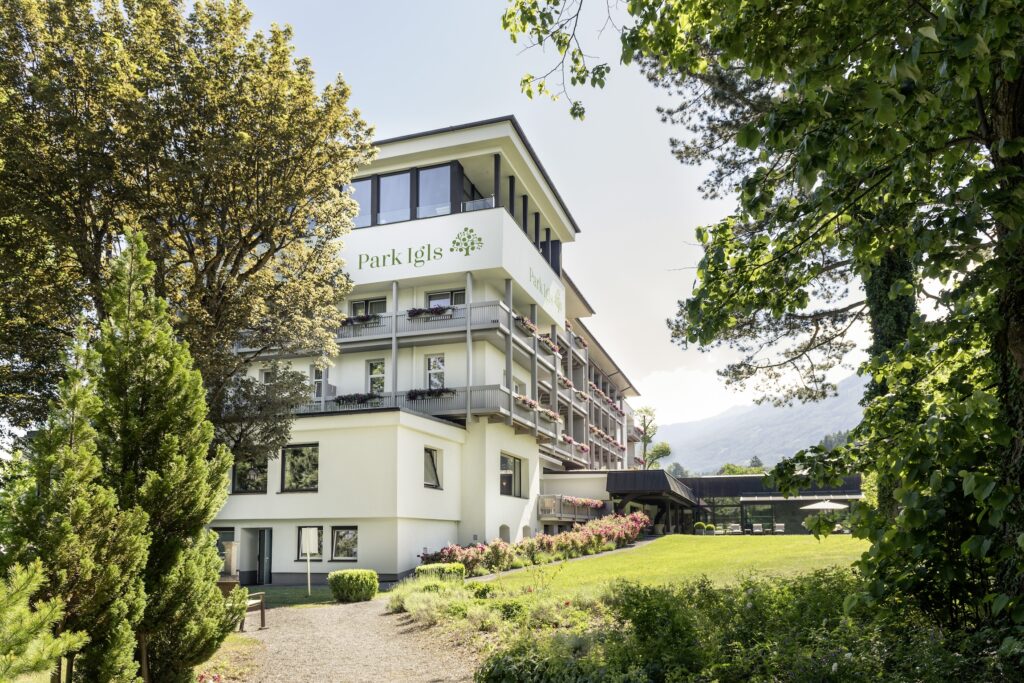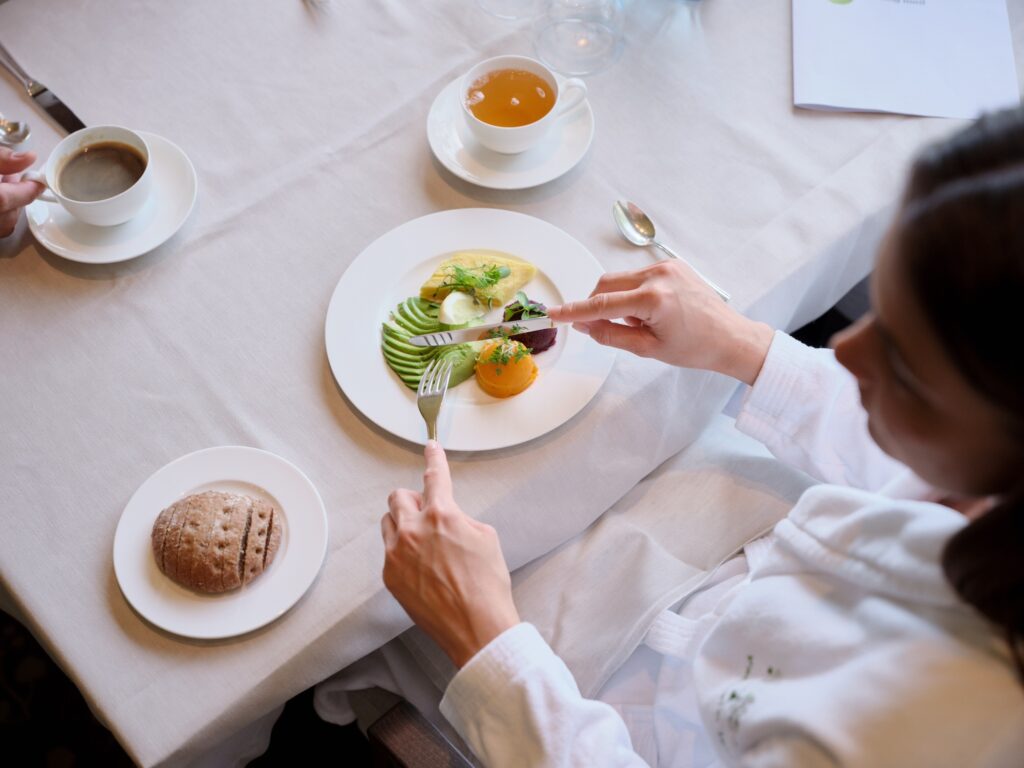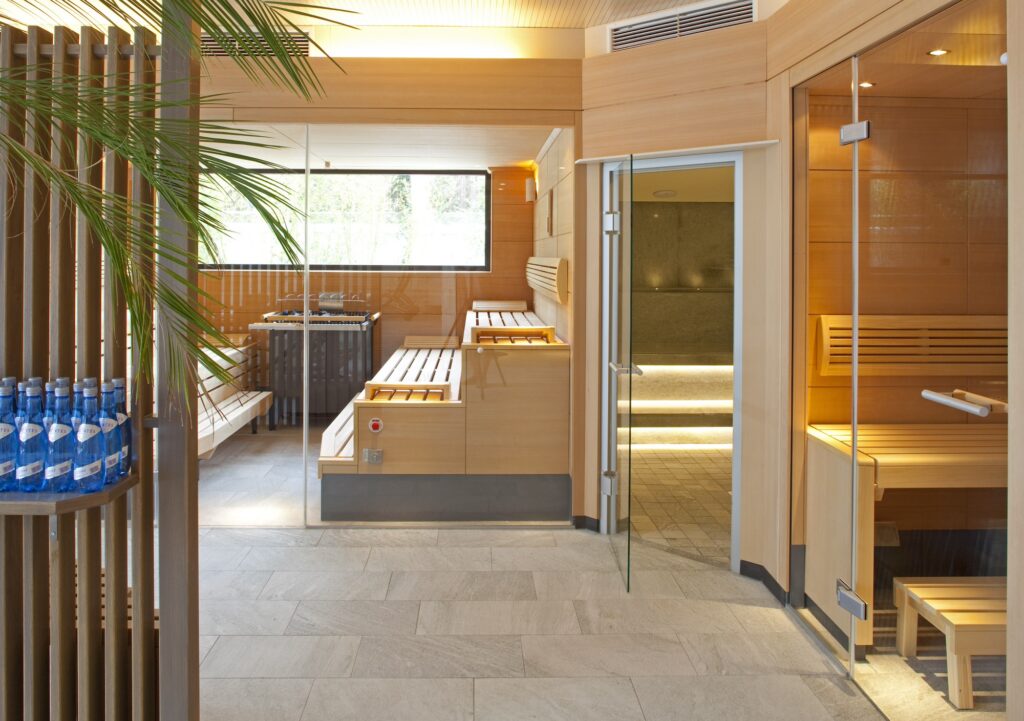Travel
Inside Park Igls Medical Spa Resort: “I left lighter in every sense”
Editorial Director Ellie Smith reports back after a transformational seven-day Mayr Detox at Park Igls Medical Spa Resort.
Before gut health was the science-backed trend it is today, there lived an Austrian doctor called Franz Xaver Mayr. At the turn of the 20th century, he came to the, then counter-cultural, conclusion that the gut is ‘the root system’ of the human body. Digestive disorders, he theorised, are the underlying cause of disease and it’s possible to diagnose, treat and even prevent illness via this all-important organ.
And so, long before scientists began to take great interest in the weird and wonderful microbiome, Dr Mayr was guiding patients back to good health with a unique, gut-focused protocol that’s come to be known as ‘The Cure’.
Fast forward 100 years and Modern Mayr Medicine practitioners continue to follow his core principles (more on these shortly), tweaking protocols here and there to keep up with ever-evolving gut science.
Leading the charge is the team at the award-winning Park Igls Medical Spa Resort – a high-tech homage to their founding father, nestled amongst the Austrian Alps, just south of Innsbruck. It’s here that I would be spending seven days, experiencing ‘The Cure’ firsthand.

The Mayr detox
As my plane landed on the tarmac at Innsbruck Airport, I realised I wasn’t entirely clear on what ‘The Cure’ would involve, other than a sneaking suspicion that there wouldn’t be heaps of eating involved. No food is fine, I thought, as long as I get a chance to slow down and switch off.
Like so many of us, I’d piled too much onto my plate (figuratively and literally) in the weeks and months leading up to the trip. So, as I drove through the alpine landscape on my way to Park Igls, I kept my fingers crossed that the protocol would be more restorative than rigorous. I dreamt of flopping from treatment bed to treatment bed being prodded, massaged and detoxed into a calmer, happier and more rejuvinated version of myself.
I’m pleased to report that the Detox Classic programme is indeed restorative. While your body is hard at work detoxing, you’re encouraged to take plenty of rest with time spent by the pool, on a massage bed, taking gentle exercise or learning about Mayr principles in group classes and lectures.
The Detox Classic is the recommended introduction to The Cure and includes the following services:
- 1 x 30-minute initial examination and health check
- 1 x 20-minute follow up medical examination and manual abdominal massage
- 1 x 30-minute concluding examination
- 5 full-body massages
- Personal modern Mayr diet plan
- Group exercise and lifestyle coaching sessions
- Lectures and presentations
- Use of the swimming pool, sauna and panoramic gym
- Daily Kneipp bathing treatments
The prescription
The team of doctors, psychologists, massage therapists and friendly spa staff at Park Igls personalise the protocol for each guest and so everyone’s experience will be slightly different.
At my initial health check, I tell the doctor I’m keen to lose some weight, boost autophagy and cell repair and generally feel fantastic. She’s open to this (prescribing me a very light diet plan – with extra protein to help me hold on to my muscle) but gently encourages me to turn my attention to high stress levels too. Perhaps it’s my jittery, running-on-adrenaline demeanour that’s giving me away. A number of laid-back exercise sessions are added to my plan, along with group stress-management classes.
Throughout the week I ask other guests for more details about ‘The Cure’ they’ve been prescribed. I met a midlife woman who spent much of her time slathered in mineral-rich mud to (successfully) relieve her arthritic joint pain. At our daily foot bath, another woman confided in me that she’d been coming to Park Igls for many decades and credited the programme with curing her infertility. A married couple shared they’d come to the resort to kick off their retirement and recover from recent health-scares. They knew they’d probably eat and drink too much if they went on a traditional holiday, the husband explained, and so they’d taken a leap of faith and tried something new. And, of course, there were the frazzled professionals – identifiable by the way they’d sneak their smartphones under the breakfast table to anxiously check their emails. They flocked to Park Igls because, like me, their always-on lifestyle was leaving them fast running out of rope.
Eat like Mayr
Eating is a very serious business at Park Igls. You’re handed a booklet of rules on arrival and I was surprised to discover that most are concerned not with what to eat, but how to eat.
Modern eating practices put a huge amount of stress on the gut, Head Physician Dr Gartner explained. These include eating too fast, eating while distracted (in front of the telly, or at our desks); not chewing our food properly; not taking proper breaks between meals (ie. snacking); and eating our biggest meal in the evening.
These habits are swiftly broken at Park Igls. Guests are encouraged to sit alone and eat in silence where possible. There’s strictly no snacking allowed: a light breakfast, lunch and dinner are served at four-hour intervals, with the evening meal being the lightest of all (two crackers and 30 grams of a protein-rich food such as cheese, fish or meat). Smartphones and reading material are discouraged in the dining room and guests are instructed to leave a minimum of 30 minutes for each meal to allow sufficient time to chew each mouthful until fully liquidised. This, Dr Gartner explained, gives the enzymes in saliva a chance to ‘predigest’ food and take the pressure off our gut. This rule doesn’t just apply to solid foods, but also to liquids such as broth and milk, which you quickly learn to ‘chew’ and swill around your mouth, mixing with saliva before finally swallowing.
Key to becoming a Mayr-certified chewing pro is the stale rye roll served with every meal. It’s tough, dry and difficult to eat, but this is no accident: if you have the patience to chew this, you have the patience to chew anything.
Another Mayr trick designed to slow down speedy eaters is tiny cutlery. You’re presented with a teaspoon to eat a big bowl of broth and instructed to place your cutlery down in between each mouthful. These rules sound bizarre to the uninitiated but there’s method in the madness. I’d arrive at meals ravenous (I estimated I was being served 600 calories a day) but often found myself unable to finish the tiny serving of soup, yoghurt or fish. Eating at such a slow pace gives our satiety hormones a chance to catch up and let us know we’re full, Dr Gartner explained. And since returning home, I’ve found that slow and steady really does win the race. By putting my cutlery down in between each mouthful, I’m no longer the first to clear my plate at every table and feel more tuned into my natural hunger cues.

Disconnect to reconnect
It took less than 24 hours at Park Igls for me to begin to struggle with all the tech-free time. My first day started with a medical examination, followed by a quiet breakfast and 45-minute ‘cell training’ treatment. The latter involves lying in silence with a mask strapped to your face that manipulates air flow (it alternates between very high concentrations of oxygen and low concentrations that are said to mimic the cardiovascular benefits of high-altitude training).
This breathing exercise takes concentration and focus, the tough-love spa attendant told me, and I mustn’t look at either my phone or the bag of books I’d optimistically carted into the treatment room with me. The 45 minutes crawled by with nothing to occupy myself and I was surprised to discover that somewhere along the way I’d lost the ability to just be, without all the doing. I’d not allowed myself to be bored for such a long time and a 45-minute dose was somewhat panic-inducing.
When the attendant returned to free me from my mask, I leapt from the bed relieved. Next on the agenda was my daily Kneipp therapy at the communal baths, which involves plunging feet into hot and freezing cold water. Perfect, I thought – some downtime to catch up on emails, check the news back at home and switch off with a scroll on social media. Alas, this was not to be. Once I arrived at the baths, I was horrified to discover notices pinned to the walls marking the area as yet another tech-free zone. Far too old (and British) to throw a tantrum, I sulked my way through the bathing ritual, watching the clock as my phone burned a hole in my pocket.
As the days progressed, however, I grew more accustomed to the vast swathes of silence and started to notice the benefits of breaking up with my phone. I began to experiment with switching it off altogether and leaving it behind in my room. My stress levels started to come down and the fever pitch of my mental chatter began to subside with more time to let my thoughts wander and my mind rest.
I noticed I was less withdrawn and more eager to engage with other guests. Far from something to sulk through, a leisurely morning at the foot baths became the highlight of my day – a chance to catch up with other guests, hear about what they were learning or simply sit in silence.
I fell in love with Austrian bathing culture – a multi-generational wellbeing ritual that we’re sorely lacking in the UK. In fact, I was so thoroughly converted, I stripped off to join other guests in the ripping hot, nude-only Finnish sauna. I’d sworn blind on the first day that I wouldn’t be caught with my kit off, and yet here I was scrubbing my nude body with eucalyptus salts and squealing with the other women as we threw ourselves into the icy plunge pool.

Lasting results
A week later, I gazed back at my reflection in the mirror and the transformation was quite extraordinary. I’d lost two kilos of body fat but that was the least of it. I looked bright-eyed, bushy-tailed and felt calm and connected. My shoulders had crept down away from my ears and my phone was tucked away and forgotten in my handbag.
If you’d asked me how I was feeling before my stay, I would have probably answered, “busy, but okay!”. With hindsight and a dash of Mayr magic, I could now see I’d been flat and running on adrenaline. When we’re chronically stressed, a muted and frantic existence becomes the norm. It’s only when I came out the other side that I realised how poorly I’d been taking care of myself and what I’d been missing along the way.
My time at Park Igls had broken the spell and given me a shot at getting back on track with more natural rhythms of living, eating and working. The protocol is designed to deliver short-term results and it does. But, the team are also dedicated to setting you up with habits to take home with you. For me, this has been the lasting legacy of my time at Park Igls. Now, almost three months later, I take time to eat properly, avoiding snacks and digital distractions. You won’t find social media or even a web browser on my now not-so-smart phone. I actively seek out pockets of silence and, much to the horror of other Londoners, have taken to the Austrian custom of cheerfully greeting strangers on my morning dog walks. I carry a piece of Park Igls with me and I’m much happier and healthier for it.
If you’re feeling less than well, physically or psychologically, Park Igls is a balm. Give yourself over to the rules and rituals and you’ll discover there’s something about The Cure that lets you shed the behaviours and habits that are keep you from living life to the full. This was certainly my experience.
Ellie stayed at Park Igls Medical Spa Resort. Rooms from €202 per person per night. Accommodation prices include breakfast, parking and transfers to/from Innsbruck Airport or Station.
The 7-day Detox Classic programme – a good introduction to Modern Mayr Medicine – is priced at €1,993 per person and includes examinations, massages, a personalised Modern Mayr Cuisine diet plan and a range of optional on- and off-site activities.
Prices correct at time of publishing.





